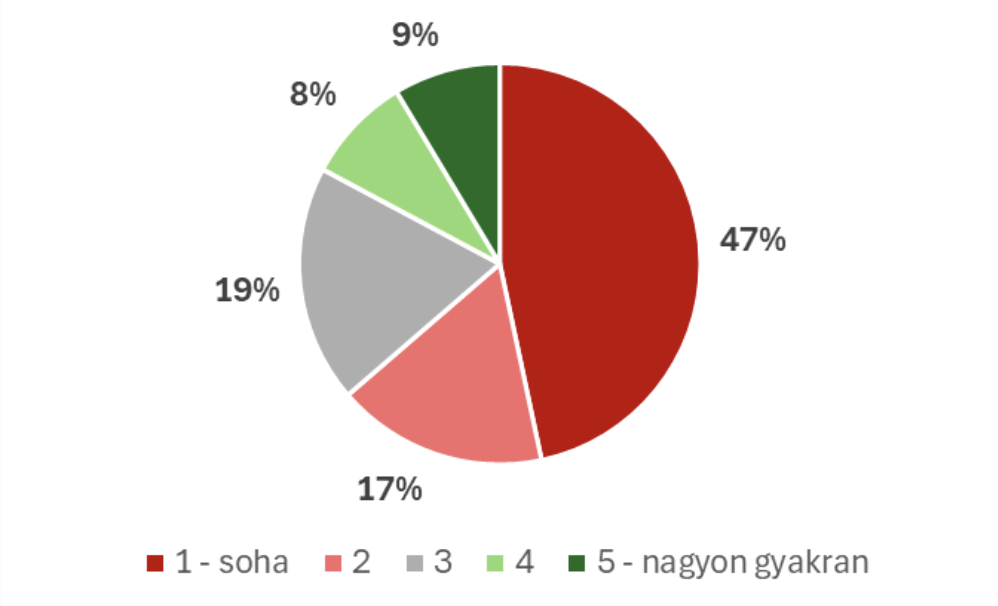GKI Analysis: Artificial Intelligence in the Workplace: Who Uses AI?
Artificial Intelligence in the Workplace: Who Uses AI?
In July, GKI conducted a representative survey of 1,000 people to assess the prevalence of artificial intelligence (AI) in Hungary. Who uses AI and for what purposes? How widespread is it in Hungarian workplaces? These are the questions the research aimed to answer.
Almost half of respondents never use AI in their work or studies, and another 17% only use it very rarely. However, 8% use it frequently, and 9% very frequently. Personal use shows slightly more favorable trends: 64% have used AI for private purposes (with one-third of them — 20% overall — doing so frequently).
How often do you use AI-based software in your work/studies?

Source: GKI survey
From a demographic standpoint, the most significant differences appear across age groups: the younger someone is, the more likely they are to use artificial intelligence.
90% of surveyed students have used AI for their studies, with 42% using it very frequently and another 16% frequently. Among active workers, 56% use some form of AI in their jobs, and 17% do so frequently or very frequently. The younger generations entering the workforce will likely further accelerate the spread of AI in the future.
Attitudes toward AI use in the workplace – balance scores by age group and occupation (lower values indicate less frequent usage)

Source: GKI. Note: The responses were converted into a scale from -100 to +100, where -100 indicates no AI usage, 0 indicates moderate usage, and +100 indicates very frequent usage.
By occupation, those in independent intellectual professions are the most likely to use AI in their work. They are followed by managers and office workers in the private sector. AI usage is less common among entrepreneurs and even less common among public sector office workers.
In Budapest — partly due to the dominance of the service sector — a higher proportion of respondents use AI than in other types of settlements. The good news is that there are no observable differences in AI usage between men and women.
Although 70% of respondents perceive some level of threat from AI in relation to their job in the next five years, only 5% consider it significant. Interestingly, young people — who are also more enthusiastic AI users — are more concerned about losing their jobs to AI. Similarly, students are more worried about their future employment than those already in the workforce. Office workers in the private sector are the most likely to feel threatened by AI, while independent intellectual professionals are the least concerned about losing their jobs to technology.
Related news
The digital ecosystem is transforming: AI is coming alongside search, not replacing it
🎧 Hallgasd a cikket: Lejátszás Szünet Folytatás Leállítás Nyelv: Auto…
Read more >Fidelity Outlook 2026: Who will bring the pick and shovel to artificial intelligence?
🎧 Hallgasd a cikket: Lejátszás Szünet Folytatás Leállítás Nyelv: Auto…
Read more >Not from the couch, but from the office: We upload our resume after lunch, and resign mentally during snack time
🎧 Hallgasd a cikket: Lejátszás Szünet Folytatás Leállítás Nyelv: Auto…
Read more >Related news
Crowds return to stores: margin cap and year-end preparations drive retail traffic
🎧 Hallgasd a cikket: Lejátszás Szünet Folytatás Leállítás Nyelv: Auto…
Read more >The kings of the New Year’s Eve list: hot dogs and champagne in abundance
🎧 Hallgasd a cikket: Lejátszás Szünet Folytatás Leállítás Nyelv: Auto…
Read more >The Alföldi Tej case is drifting towards an uncertain outcome
🎧 Hallgasd a cikket: Lejátszás Szünet Folytatás Leállítás Nyelv: Auto…
Read more >






